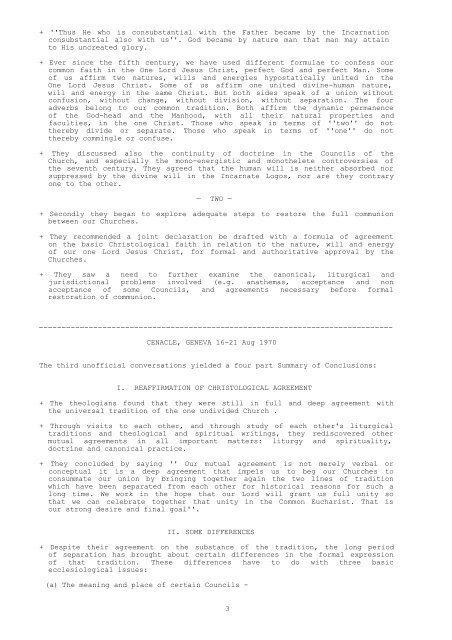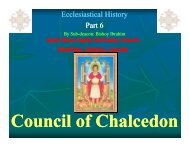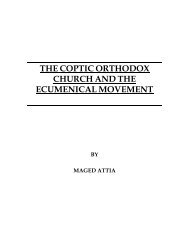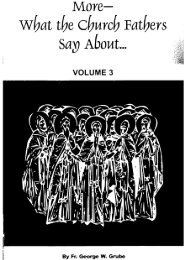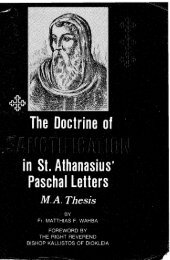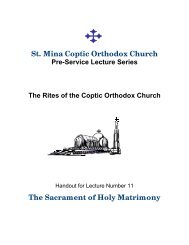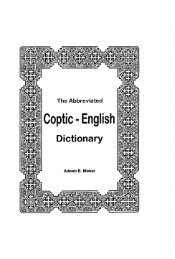Coptic interpretations of the Fourth Ecumenical Council - Saint Mina ...
Coptic interpretations of the Fourth Ecumenical Council - Saint Mina ...
Coptic interpretations of the Fourth Ecumenical Council - Saint Mina ...
You also want an ePaper? Increase the reach of your titles
YUMPU automatically turns print PDFs into web optimized ePapers that Google loves.
+ ''Thus He who is consubstantial with <strong>the</strong> Fa<strong>the</strong>r became by <strong>the</strong> Incarnation<br />
consubstantial also with us''. God became by nature man that man may attain<br />
to His uncreated glory.<br />
+ Ever since <strong>the</strong> fifth century, we have used different formulae to confess our<br />
common faith in <strong>the</strong> One Lord Jesus Christ, perfect God and perfect Man. Some<br />
<strong>of</strong> us affirm two natures, wills and energies hypostatically united in <strong>the</strong><br />
One Lord Jesus Christ. Some <strong>of</strong> us affirm one united divine-human nature,<br />
will and energy in <strong>the</strong> same Christ. But both sides speak <strong>of</strong> a union without<br />
confusion, without change, without division, without separation. The four<br />
adverbs belong to our common tradition. Both affirm <strong>the</strong> dynamic permanence<br />
<strong>of</strong> <strong>the</strong> God-head and <strong>the</strong> Manhood, with all <strong>the</strong>ir natural properties and<br />
faculties, in <strong>the</strong> one Christ. Those who speak in terms <strong>of</strong> ''two'' do not<br />
<strong>the</strong>reby divide or separate. Those who speak in terms <strong>of</strong> ''one'' do not<br />
<strong>the</strong>reby commingle or confuse.<br />
+ They discussed also <strong>the</strong> continuity <strong>of</strong> doctrine in <strong>the</strong> <strong>Council</strong>s <strong>of</strong> <strong>the</strong><br />
Church, and especially <strong>the</strong> mono-energistic and mono<strong>the</strong>lete controversies <strong>of</strong><br />
<strong>the</strong> seventh century. They agreed that <strong>the</strong> human will is nei<strong>the</strong>r absorbed nor<br />
suppressed by <strong>the</strong> divine will in <strong>the</strong> Incarnate Logos, nor are <strong>the</strong>y contrary<br />
one to <strong>the</strong> o<strong>the</strong>r.<br />
— TWO —<br />
+ Secondly <strong>the</strong>y began to explore adequate steps to restore <strong>the</strong> full communion<br />
between our Churches.<br />
+ They recommended a joint declaration be drafted with a formula <strong>of</strong> agreement<br />
on <strong>the</strong> basic Christological faith in relation to <strong>the</strong> nature, will and energy<br />
<strong>of</strong> our one Lord Jesus Christ, for formal and authoritative approval by <strong>the</strong><br />
Churches.<br />
+ They saw a need to fur<strong>the</strong>r examine <strong>the</strong> canonical, liturgical and<br />
jurisdictional problems involved (e.g. ana<strong>the</strong>mas, acceptance and non<br />
acceptance <strong>of</strong> some <strong>Council</strong>s, and agreements necessary before formal<br />
restoration <strong>of</strong> communion.<br />
CENACLE, GENEVA 16-21 Aug 1970<br />
The third un<strong>of</strong>ficial conversations yielded a four part Summary <strong>of</strong> Conclusions:<br />
I. REAFFIRMATION OF CHRISTOLOGICAL AGREEMENT<br />
+ The <strong>the</strong>ologians found that <strong>the</strong>y were still in full and deep agreement with<br />
<strong>the</strong> universal tradition <strong>of</strong> <strong>the</strong> one undivided Church .<br />
+ Through visits to each o<strong>the</strong>r, and through study <strong>of</strong> each o<strong>the</strong>r's liturgical<br />
traditions and <strong>the</strong>ological and spiritual writings, <strong>the</strong>y rediscovered o<strong>the</strong>r<br />
mutual agreements in all important matters: liturgy and spirituality,<br />
doctrine and canonical practice.<br />
+ They concluded by saying '' Our mutual agreement is not merely verbal or<br />
conceptual it is a deep agreement that impels us to beg our Churches to<br />
consummate our union by bringing toge<strong>the</strong>r again <strong>the</strong> two lines <strong>of</strong> tradition<br />
which have been separated from each o<strong>the</strong>r for historical reasons for such a<br />
long time. We work in <strong>the</strong> hope that our Lord will grant us full unity so<br />
that we can celebrate toge<strong>the</strong>r that unity in <strong>the</strong> Common Eucharist. That is<br />
our strong desire and final goal''.<br />
II. SOME DIFFERENCES<br />
+ Despite <strong>the</strong>ir agreement on <strong>the</strong> substance <strong>of</strong> <strong>the</strong> tradition, <strong>the</strong> long period<br />
<strong>of</strong> separation has brought about certain differences in <strong>the</strong> formal expression<br />
<strong>of</strong> that tradition. These differences have to do with three basic<br />
ecclesiological issues:<br />
(a) The meaning and place <strong>of</strong> certain <strong>Council</strong>s -<br />
3


